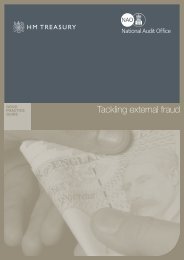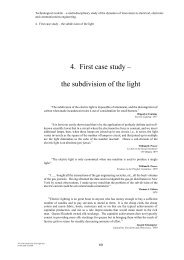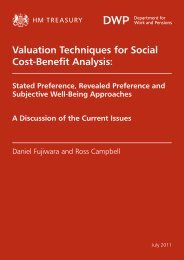Valuing Our Natural Environment Final Report ... - HM Treasury
Valuing Our Natural Environment Final Report ... - HM Treasury
Valuing Our Natural Environment Final Report ... - HM Treasury
Create successful ePaper yourself
Turn your PDF publications into a flip-book with our unique Google optimized e-Paper software.
<strong>Valuing</strong> <strong>Our</strong> <strong>Natural</strong> <strong>Environment</strong> – <strong>Final</strong> <strong>Report</strong> - Annex1<br />
and local, the jurors may be selected as key stakeholders / representatives of different<br />
points of view, rather than randomly.<br />
A1.2.3.10 Key uses – coverage of natural environment<br />
The citizens’ jury process can be applied to any resources, but as noted, they are<br />
particularly suitable where there are fundamental issues at stake. For example,<br />
applications to nuclear waste storage, GM crops, nanotechnology, as well as wind farm<br />
siting, fisheries policy, national park creation, managed realignment and so on. A recent<br />
example in a UK context is provided by the UK CEED Consensus Conference on Radioactive<br />
Waste 2 .<br />
A1.2.3.11 Discussion<br />
Citizen’s Juries differ from other group consultation methods in being very time- and<br />
resource-intensive but allowing for informed public opinion to be explored in a very high<br />
level of depth and detail. A wide range of information is incorporated, under control of the<br />
jurors, and there is time for this information to be considered, discussed, checked and so<br />
on. Thus the extent to which the views expressed can be thought of as well-informed and<br />
carefully considered is greater than for less intensive group techniques and some surveybased<br />
methods.<br />
A1.2.3.12 Consideration of distributional impacts<br />
Within the citizens’ juries process there is clear bias towards the more vocal and/or better<br />
informed participants (note that these may not necessarily be the same people). As<br />
Lenaghan et al. (1996) note some jurors will be more articulate, confident, and<br />
experienced and better educated, and will tend to dominate the discussions when all the<br />
jurors were present. As a way around this, they suggest splitting the jury into two smaller<br />
groups. In practice the CJ will involve plenary sessions, working groups etc., which involve<br />
bringing different people to work and discuss together.<br />
Aside from this, there is no obvious systematic bias in the citizens’ jury process, provided<br />
the group is randomly selected. However there is likely to be random bias within any<br />
group, since the selection cannot be representative due to the small size of the group.<br />
There may also be bias introduced because of the time commitment required: ‘busy’<br />
people may find it hard to take part, so there may be bias towards those with more “spare<br />
time” (the retired, unemployed, possibly students, etc), those with fewer family<br />
commitments, or lower-paid people for whom the compensation payments give a strong<br />
incentive to participate.<br />
Like other non-economic techniques, expressions of value are not made through willingness<br />
to pay, and so there is no distributional/equity issue with value being constrained by ability<br />
to pay.<br />
A1.2.3.13 Advantages and disadvantages<br />
Due to the opportunity for informed deliberation, citizens’ juries may provide a better<br />
approach to tackling complex questions and difficult choices than other discursive methods<br />
(Coote and Lenaghan, 1997; Kenyon, 2001). However, the main disadvantage of the<br />
approach lies in that it is not necessarily representative and potential problems can be<br />
envisaged where decision-makers go against citizens’ juries’ verdicts. Other possible<br />
disadvantages include:<br />
• raising expectations that agency will do what jury suggests;<br />
• timescale – tend to be one-off;<br />
• sometimes no consensus is reached, so the jury does not necessarily reach a unanimous<br />
verdict, but can highlight areas of concern/disagreement;<br />
• the need to be careful that the expert/lay divide does not mean that the jury just<br />
regurgitates what it is told;<br />
2 http://www.ukceed.org/consensus_conference/contents.htm<br />
eftec A40<br />
December 2006





![AIRTO [Professor Dr Brian Blunden] - HM Treasury](https://img.yumpu.com/15492848/1/184x260/airto-professor-dr-brian-blunden-hm-treasury.jpg?quality=85)










